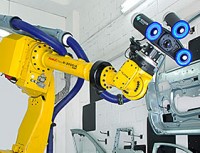Compared to older measuring tools, 3D scanners are known for their increased accuracy. But what happens when a 3D measurement scanner is in human hands rather than secured to a stable surface? While keeping your scanner stationary in your lab, workshop, or business is sometimes an option, many industries may rely on the portability of a handheld 3D measuring scanner. Your work takes you to amazing places, and your 3D scanner can go with you. There are a few important details to understand about the accuracy of handheld 3D scanners when you take them out in the field or even when using them in a controlled environment. While these devices maintain an extremely high degree of accuracy, knowing about the factors that can affect their measurements will ensure you get the most out of your equipment.
3D Measurement Scanner Accuracy Factors
The accuracy of a scan is measured in millimeters, and most high-quality 3D scanners are accurate within mere tenths of a millimeter. Miniscule measurements make a difference in manufacturing and other industrial settings in which a 3D scanner is required, such as when a color map comparison is needed to make sure a part is at tolerance, so an accurate scan is of utmost importance. If you’re concerned about scan accuracy while using a handheld 3D scanner, rest assured that the best handheld 3D measuring scanner still achieves accuracy within a few tenths of a millimeter, and all handheld 3D scanners are still accurate within several millimeters.
Knowing about the scanner’s sensor, evaluating its hardware and calibration device quality, and thinking ahead about the environment in which the scanner will be used will all help you to choose a scanner with a range of accuracy that suits the needs of your application. Whether you are using a 3D scanner with the goal of reverse engineering to create a CAD model or even require a First Article Inspection, scanner accuracy ensures you get the digital data you need in the post-processing phase.
Scanner Sensor
3D scanner measurement works because a sensor reads the visual data the scan creates. While each scanner has an overall high degree of accuracy, some variation exists among sensors. For example, some scanners have a single sensor while others have multiple sensors. Structured light systems compare data from multiple sensors, laser scanner sensors use a single sensor to read the laser. Varying distances from the object can also impact sensor measurement accuracy.
Hardware Quality
When it comes to accuracy, materials matter. The exterior housing of a handheld 3D scanner in addition to the way it is assembled and the ease with which you can handle the device will all impact the accuracy of scans. At Exact Metrology we can introduce you to a wide range of handheld scanners so you can find your perfect fit. If you will be using your scanner frequently, ergonomic comfort is key.
Device Calibration
It is crucial for a handheld 3D scanner to be properly calibrated to achieve consistently accurate results. Because they are portable, it is possible for handheld 3D scanners to lose calibration more quickly than a scanner in a stationary environment. Be sure to carefully calibrate your device for the best accuracy every time.
3D Scanner Environment
The environment in which the handheld scanner is being used can impact its accuracy. For example, ambient light or electromagnetic interference can decrease accuracy. Depending on your application, you may choose to go with a higher accuracy model. The increase in accuracy will mitigate challenging environmental factors including lighting and other machinery-related conditions in addition to outdoor conditions.
This content was originally published on the Exact Metrology website.

